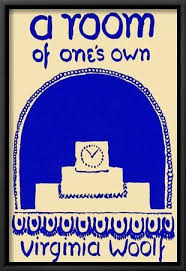A Room of One's Own by Virginia Woolf
INTRODUCTION
The novel A Room of One’s Own is based on
two lectures Virginia Woolf gave in 1928 at Cambridge University’s Newnham
College for Women. In 1929, she expanded the lectures and published them as a
single lengthy essay. Woolf starts talking about women and fiction in it, but
she rapidly moves on to a larger discussion of sexism in art and how it affects
women’s creativity in particular. In order to understand more about women and
literature, she sets out to explain her own perspective on the subject in the
essay. She discovers a dearth of noteworthy female writers before the
nineteenth century.
Woolf ponders about the possible reasons
of poverty, lack of education and social norms that restrain women in their
home. Prior to the 17th Century, there was an inaccessibility of
knowledge regarding the daily lives of women as well as a lack of female
authors. According to the male perspective, women were shown only in the works
of literature produced by men. In response, Woolf imagines the lives of female
characters in order to understand why female authors have historically been so
rare in literature. At the time of the article's publication, Woolf's literary
reputation had already been established.
She was a part of the modernist literary
movement as a result of World War I. Modernism has new ways of expressing
itself in classic literary genres like novels and poetry. Woolf employed a
technique known as “tunneling” in her essay, in which she excavates a
character’s inner lives, dreams, and cognitive processes to make it presentable.
She looks for the truth hidden beneath the surface elements of daily life. Her
novels Mrs. Dalloway (1925), To the Lighthouse (1927), and Orlando A Biography
(1928) all make use of this style.
The title “A Room of One’s Own” refers to
women’s freedom, women’s writers, and a personal space so she can write
effectively and valuable things. In this way, women will be able to get to the
level of Shakespeare, and factors like androgyny, female self-independence and
female literacy traditions will take place in society and then only they will
be known by their own identities. Here the title: “A Room of One’s Own” it is
not only about the physical room; it is about “freedom of thoughts and
decisions” as well as “personal space.”
Woolf adopts a fictional persona named
“Mary Baton” and addresses her audience and readers using that identity. The
name comes from an old Scottish ballad, commonly known as “Mary Hamilton” or
“The Four Marys’.” Mary becomes pregnant by the king, but kills the child and
is later sentenced to death for the crime. “Mary Baton” is one of three other Marys
in the ballad.
Woolf reflected on the ways in which women
have been excluded from social and political institutions throughout history,
and illustrates her point by noting that a woman could not have access to
manuscripts held at male college. At Oxbridge (a rhetorical combination of
Oxford and Cambridge) Woolf originally gave, “A Room of One’s Own” to the
students of Cambridge’s newly founded women’s college, but these female
students were still not allowed to enter certain rooms in the all-male
colleges.
Later, Woolf turns her attention to what
men have said about women in their writing, and she finds that, men whose
interests are in maintaining their dominance over literature and
education-represent women in certain ways in order to effectively preserve
them. According to men, women are second class citizens.
Looking at the contribution of women writers,
Woolf perceive that there is no statistics about life of women so she decided
to make up a story about Judith Shakespeare (William Shakespeare’s sister), a
woman who had capability to write a word but she never tried because society
was against women. But now it is possible for women to write. The novelist records
the history of women writers, and their influence on each other. In several
generations women should be able to write brilliant poetry that Shakespeare was
able to bring off. But until now, the literature produced by women is full of
harsh, difficult writings, stories that cannot go beyond the range of their
gender and flow freely.
After receiving the story, Woolf leaves the
character, wondering how will she end her lecture with an encouraging call to action.
She gave mission to her audience with help of women from Newnham and Girton
college to shape a legacy for their daughters. She considered the fiction is a
universal good not just an individual, and there is something worldwide and
powerful about it. She creates an image of Judith Shakespeare lying dead on the
slum streets of London, asserting that the tragic figure is not lost. Since the
poets never really die, but are seen in different light by other people. The
women who were in the audience were able to give Judith the life that she never
had. They used the works of real and fictional writers like Judith and Virginia
Woolf, to argue for women’s economic and artistic freedom. This freedom and independence
map the work of future women writers and her contemporaries towards equality
with men in the field of literature.
Although this novel was published almost a hundred years ago, its statement still holds true. Considered a breakthrough in 20th century feminism, Woolf exposes many social injustices and comments on the opportunities for women to become writers and participate in shaping world literature. In Woolf’s opinion the patriarchal way of thinking of the era, meant that the literary tradition was governed by men and left no room for female creativity.
In 1929, almost a hundred years ago, Virginia Woolf’s “A Room of One’s Own” was published and this thesis can be extended to all modern creative people who devote their time to making visionaries. Despite writing a hundred years ago, Woolf produces many letters that neither time nor judgment has prevented from remaining relevant today.
When Woolf gave the lectures that inspired
her work, she intended to convey the message that sexism is still as prevalent
in the creative arts as ever. Woolf described situations where a person had
both time and space to create: that is, money and space to work. It was not
unusual for property to pass through the male line and male inheritance was
very common. Men get an unquestionable acceptance to study. At the same time,
women who wanted to write were forced to bend over tables in common rooms to
perform women’s tasks. Children, housekeeping, and childbirth prevented her
from simply sitting down and putting pen to paper. Even if she had time to
write the beginning of the script, she would have to hide her work for fear of
ridicule. For Woolf, sexism was no less of a problem than before, despite many
people pretending otherwise.
Although Woolf’s “A Room of One’s Own”
focuses specifically on struggle women have faced in creating literary works
throughout history, her thesis can be extended to the present too. It is important
to understand the timing of these remarks by Virginia Woolf that society
actively encouraged romance and creativity, not suppressed it. However,
creativity had to be left to the men of society, which left a shadow for women
to participate in the development of fiction at the same pace. This is a point
that Woolf makes several times in her book – creativity was not discouraged, it
was simply kept over the heads of women.
Woolf hoped that her work would show the
hypocrisy of writing industry, which left women behind while men were given all
the resources they had to create. It can be argued that modern society
continues to isolate creativity from even more groups of people than Woolf
realized.
Virginia Woolf emphasized the importance
of economic stability. In Woolf’s time, women either relied on men or worked in
low-paying jobs. Now, most of the people are completely dependent on
themselves. The first way to deal with the inability of artists to fulfill
their desires is to understand the economic value of art from the perspective
of both volume and time. It is also important to learn the value of personal
space for creative work.
The fact that social criticism is old does
not mean that it is no longer relevant. Woolf’s nearly 100 years of work highlights
society’s failure to allow artists to do what they do best. What Woolf sought
to address is now more common than ever. Society must strive to better
appreciate art, time, creators, and the flowering of art.
Especially today, the feminist movement
has different goals, both moral and political. We have several feminist
thinkers and activists across the political spectrum who stand up for equality
between men and women. In her essay “A Room of One’s Own,” Virginia Woolf
presented all the problems related to women. Her goal in writing was to reform
the position of women and the patriarchal society. Most critics praised Woolf
for her values and morals, which she used in her essays. Through the essay, she
conveyed a good message to readers.
Works Cited:
“A Room of One’s Own” by Virginia Woolf.
“A Room of One’s Own,” Virginia Woolf 1929
(encyclopedia.com)
“A Room of One’s Own”: Symbols
(sparknotes.com)
Significance of the Title (shmoop.com)
Summary (litcharts.com)
A Summary and Analysis of Virginia Wolf’s
A Room of One’s Own (interestingliterature.com)
The Importance of Having “A Room of One’s
Own” (youthtimemag.com)
A Room of One’s Own Analysis
(edubirdie.com)
NOTE: This blog is written by my students of TYBA (English): Noor Zehra Saiyed, Sakina Saleh
Aafiya Sayed, Anisa Shaikh and Misbah Shaikh.




👌👌👍👍❣️
ReplyDelete